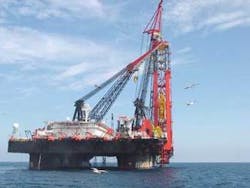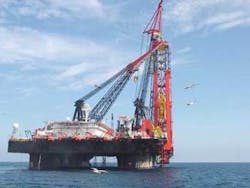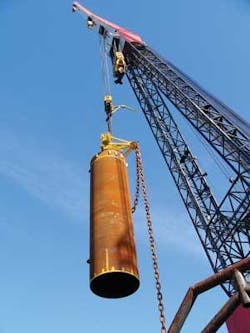Steel wires set records in deepwater
Lowering capacities of 1,000 metric tons in 3,000 m of water is economically feasible
Kees van Zandwijk, Anke Cotteleer, Frank Lange - Heerema Marine Contractors
A new record for installing heavy structures in deepwater for Heerema Marine Contractors (HMC) shows that lowering capacities of 1,000 metric tons in 3,000 m of water may be here soon. With upgrades and combinations of hoisting systems now available, these capacities are economically feasible.
Recently, HMC installed suction piles for theIndependence Hub semisubmersible production facility in the Gulf of Mexico in approximately 2,440 m of water with the Deepwater Construction Vessel (DCV), Balder.
Each suction pile weighed 220 metric tons in air, including the section of bottom chain suspended from it during installation. This is a new record for HMC in installing heavy structures in deepwater and shows the progress over the past few years in installation capability. This installation record was established using conventional steel wires.
The capability to lower heavy structures to the seabed has always been critical. That led HMC to upgrade its equipment to accommodate the requirements of deepwater developments past the depth of 2,000 m.
Limitations
The most critical deepwater lowering issue is the ability to reach deeper with wires. This is done by reducing the number of parts in the hoisting system so depth and capacity are optimized. Where wire lengths that exceed drum capacity are required, traction winches are added to the system. In principle, this can operate with unlimited wire lengths. With heavy structures in deeper waters, more attention is on the dynamics in the system and associated operational limits to keep wire tension within capacity.
Semisubmersible DCVs like HMC’sBalder and Thialf have the weight carrying capacity, deck space and minimal motion behavior for safe installation using traction winches and the industry’s longest steel wires. As a result, complex and vulnerable motion compensation systems are not required.
Technology
To improve the capability of the vessels’ cranes to install in deeper water, additional wire length can be used and/or the number of parts can be reduced. For a number of projects, the cranes were re-reeved, as an example, for the Ormen Lange templates, going from 80 parts to 12 parts. The effective payload weight (P), which can be lowered to a given depth (d), is estimated using the following formula:
P = N { C - (Wa . h + Ws . d) } - B (metric tons)
And the total length of wire (L) in the reeving system is:
L = N (h + d) (m)
Where:
N = number of parts in the reeving system
C = safe working load (metric ton)
Ws = weight of wire in seawater (metric ton/m)
Wa = weight of wire in air (metric ton/m)
h = deployment height above sea level (m)
B = weight of crane block in seawater (metric ton)
The weight (W) for one meter of wire is about 0.015% of the safe working load (C). It is evident from the above formulas that for a heavy-lift operation above water, where (h) is in the order of 100 m, the effect of the wire weight on the effective payload (P) is negligible. However, in water depths from 2,000-3,000 m, effective payload reduction is substantial, mounting to 30-45%, respectively.
It is possible to compensate for this efficiency loss from steel wires in deepwater by increasing the number of parts (N) or by using a longer wire length (L). However, the freedom to do this is limited. For hoisting drums, longer wires imply increased flange loading and higher torque requirements as the wire is spooled further from the drum axis. Adaptations of existing drums to accommodate these requirements are ineffective and often physically impossible.
In 2003, drum-based hoisting system limitations led HMC to upgrade the starboard crane of DCVBalder with two traction winches and separate storage reels with crane wire lengths of 19,000 m, the maximum lengths now produced.
Traction winches allow separating the pulling function from the drum, so the winch torque always exerts the same pull, whatever the wire length. Meanwhile, the enormous wire lengths can be stored at a place where physically possible.
By this upgrade, the vessel’s lowering capacity has been increased to 1,490 metric tons at 1,000 m, 600 metric tons at 2,000 m, and 340 metric tons at 3,000 m. The upgrade allows for the addition of two more traction winches, increasing the capacity up to 100%.
Even heavier structures can be lifted by combining the two cranes, the mooring line deployment winch, and/or the A&R winch. It is these upgrades and combinations of hoisting systems which make lowering capacities up to 1,000 metric tons in 3,000 m of water economically feasible.
Adding wire length substantially increases weight, in the order of 400 metric tons for two 19-km wires. However, this extra weight can be accommodated by a semisubmersible crane vessel with heavy-load carrying capacity. Steel wires are not the most optimal equipment for lifting in deepwater, but they have proven to be reliable, safe and economical in performance.
Dynamic behavior
Another important characteristic of a deepwater lift to address is the vessel’s dynamic behavior. When setting a load to depth, reeving system spring stiffness continuously changes, which impacts dynamic response. This dynamic amplification may consume a significant portion of the vessel’s available lifting capacity. Shape of the structure being installed also influences hydrodynamics. Compact and transparent structures induce less dynamic amplification than items shaped like a flat plate.
Analysis of the dynamics of large and heavy template lowering was conducted first in 1991 during installation of the concrete foundation templates (6,000 metric tons each) for theSnorre TLP in 340 m of water. This experience, further model testing, and additional installations over the past 15 years inspired development of specific tools to analyze the dynamics of lowering templates and suction piles in deepwater.
Reliability of these tools has been tested on more than 100 suction pile installations and a number of template deployments by HMC.
In a majority of cases, water displacement of the installed object is small compared to displacement of the installation vessel. This minimizes dynamic interaction effects. This characteristic of dynamic interaction often reduces the workability of smaller installation vessels. When the installation is performed from a semisubmersible DCV, which is little effected by wave motion, dynamics are limited and workability improved.
Experience
Recent examples of HMC projects which required increased capacity for a given water depth include installation of the Ormen Lange templates in the Norwegian Sea, and installation of suction piles for Thunder Horse, Atlantis, and Independence Hub projects in the Gulf of Mexico.
On Ormen Lange, two foundation bottom structures were set at a water depth of 850 m, each involving a total dynamic hook load of 1,645 metric tons.
This required dual crane capability with both cranes re-reeved to a capacity at the hook of 878 metric tons. The operation was weather limited due to motion behavior of the template before the suction process began.
On Thunder Horse, suction piles reaching a hook load of 270 metric tons were installed in water depth of 1,920 m. On Atlantis, similar piles were installed with hook loads of 220 metric tons in 2,130 m of water. The latest suction pile installation was completed on Independence Hub, with hook loads of 220 metric tons in 2,440 m of water. All of these projects established record-breaking combinations of hook load and water depth.
Future
With the option of including two additional traction winches on the starboard crane of theBalder, as well as placing additional winches on its other crane, reliable and cost-effective solutions are available for greater in-depth lowering capability. Steel wires prove to be a safe and reliable solution for heavy installation in deepwater.



